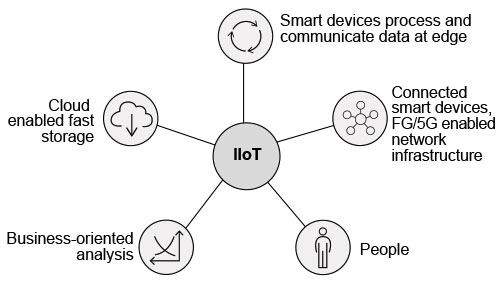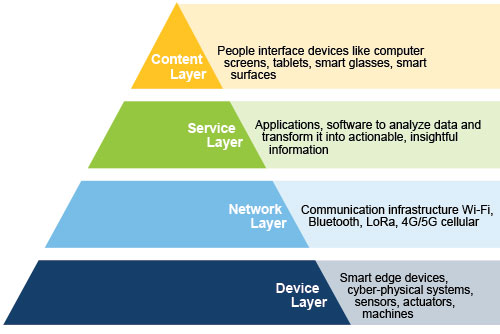- By Shiv Kataria
Summary
The smartness of a factory lies in its ability to make optimal and timely decisions.

The Internet of Things (IoT) is a recent concept that originated out of the advancement and penetration of Internet services. The term IoT was first used by Kevin Ashton in 1999 to promote radio frequency identification (RFID) technology. It means smart devices with some computational capability are connected to the Internet and support sharing data in formats that can be used for further analysis. Day-to-day consumer examples of IoT devices include Alexa smart speakers, connected cars, and smart wearables.
When the application of IoT is extended to industrial use cases, it is called IIoT. It is also sometimes referred to as “industrial Internet” or “Industry 4.0.” IIoT originated out of the commercial concept of the Internet of Things and the advancement and penetration of Internet services within industrial environments. The term “industrial Internet” reportedly was coined by GE for the convergence of critical assets, advanced predictive and prescriptive analytics, and modern industrial workers.
IIoT is a network of smart sensors, actuators, and systems using communication technologies that help in the real-time analysis and communication of data produced by the devices in the factories or field. The ability to gather real-time data enables monitoring, exchange, and analysis of the data for meaningful insights. These insights are harbingers of smarter and faster business decision making for manufacturing organizations.
In general, an IIoT ecosystem consists of the following (figure 1):
- connected smart devices that gather and communicate over a network
- a public or private communications infrastructure
- processes that analyze the data gathered by smart devices and produce business use information
- data storage that houses data in a central location
- people that consume the information to make informed decisions.

Figure 1. Industrial Internet of Things
IIoT enables the true convergence of information technology (IT) and operational technology (OT). The smart edge devices in the field or factories communicate the captured data intelligently over the communication infrastructure. The data is consumed to drive actionable information and trend analysis for machinery. The analyzed information supports informed decision making for predictive maintenance, safety, security, and business optimization.
An IIoT system with IT-OT convergence can be seen as a layered modular architecture of digital technology (figure 2). It can be divided into four technology layers: 
- Content layer: People-interface devices like computer screens, tablets, smart glasses, and smart surfaces
- Service layer: Applications and software to analyze data and transform it into actionable, insightful information
- Network layer: Communication infrastructure such as Wi-Fi, Bluetooth, LoRa, 4G/5G cellular, and other methods that send and receive the data
- Device layer: Smart edge devices, cyber-physical systems, sensors, actuators, and machines.
Trends and standards
The growing adoption and multitude of players in the IIoT space has necessitated the development of standards. In 2020, the International Organization for Standardization (ISO) and the International Electrotechnical Commission (IEC) jointly released three IoT standards:
- ISO/IEC 21823-2 specifies a framework for transport interoperability to enable information exchange within and between IoT systems.
- ISO/IEC TR 30164 describes the concepts, characteristics, and technologies of edge computing for IoT systems applications.
- ISO/IEC TR 30166 applies to IIoT systems and landscapes.
In addition, the Industrial IoT Consortium has developed several volumes of architecture and specifications for IIoT. Sixteen consortia and associations and 17 standards development organizations are helping to define and standardize the IIoT environment.
An abundance of communication standards frameworks also exist. These include: MQTT, a bidirectional TCP/IP–based publish-subscribe communication protocol; REST, a scalable Hypertext Transfer protocol used for edge-to-cloud communication; NodeRED, an open-source platform developed by IBM to connect APIs, hardware, and online services; OPC, a series of standards developed by the OPC Foundation for industrial communication to connect controllers with computers and the cloud; Chatty Things, an open framework being developed by XMPP Standards Foundation for scalable IIoT infrastructure; Cognitive IoT, a framework being developed by IBM that combines IoT with machine intelligence, contextual information, and learning using natural language processing; and Mindsphere, a cloud-based platform developed by Siemens to integrate IoT edge devices, applications, and services in one place.
These standards and frameworks are shaping the IIoT landscape, as are Industry 4.0 reference architectures being developed around the world. Industrial Internet Reference Architecture (IIRA), the German Industrie 4.0, and the RAMI model are all independent efforts to create a defined standard for IIoT-enabled facilities.
Why IIoT is important now
IIoT has affected the industrial sector significantly and brought many benefits to digital manufacturing. The advancement in IoT technologies and the availability of the Internet has helped other advanced technologies, such as cloud computing, big data analytics, and artificial intelligence/machine learning, penetrate the industry. This has comprehensively contributed to a robust infrastructure for cyber-physical systems. The traditional industrial systems like supervisory control and data acquisition and distributed control systems have improved in monitoring, performance, productivity, and, more importantly, in efficiency with the advent of IIoT, contributing to the profitability of organizations.
The convergence of the physical devices over network infrastructures with smart edge devices, real-time analysis of data from the production process, visibility into process parameters, control of processes, and data exchange have all improved significantly. Overall, IIoT has enabled data-driven decision making and positively affected the accuracy and predictability of these decisions in industrial environments.
Trends and benefits enabled by IIoT
Digitalization enabled by IIoT has been increasing rapidly during the past decade. According to a survey conducted by statista in 2020, the global market for IIoT was more than 263 billion USD. The market is expected to grow to some 1.11 trillion USD by 2028.
During the COVID pandemic, the adoption of IIoT-enabled technologies increased significantly. The remote work requirements were a push factor of this adoption. The focus of IIoT implementation in recent years has been workforce management initiatives, automation, and customer experience improvements.
The advanced applications brought about by the proliferation of IIoT technology is the most significant trend associated with IIoT. This list was compiled by ATS:
- Remote monitoring and operation: The advantage of sensor-based data analytics is to access data and devices on demand.
- Edge sensor advances: The edge capability and penetration of 4G/5G communications have enabled faster communication and robust sensors.
- Predictive analysis: Data-driven trend analysis has improved on-time maintenance, reducing downtime and increasing production.
- Digital twins: Smart sensor data feeds into digital twin models and makes remote monitoring and management more reliable and efficient.
- Health and safety: IIoT-driven technologies contributed to health and safety, especially during the pandemic time in 2020–21. Employee locations on the facility floor, tracking of close contacts, and temperature recording all contributed to safe and healthy work environments.
- Agile and flexible infrastructures: IIoT advances provide unprecedented flexibility in areas such as supply chain, so manufacturers can be agile in supplier selection, ordering and procurement strategy, and inventory management.
- Smart factory: Increased penetration and use of 5G wireless communications within factories is taking digital manufacturing in new directions. Smart factories are a reality in 2022.
- Data analysis at the source: The abundance of data generated by the smart edge devices makes it important to analyze the data at the source in a timely manner. Factories are changing their technical architecture, bringing data analysis and artificial intelligence (AI) technology out to the “edge” to take full advantage of the IIoT ecosystem.
The integration of IT and OT, increased speeds of Internet and communication technologies, and fast data analysis have supported the conversion of digital factories into smart factories. IIoT platforms integrate IT functions with OT functions and transform factory floor operations. The legacy machines and sensors are being integrated with the IT systems, and edge intelligence has been introduced. Lately, 5G penetration has accelerated this transformation by eliminating cabling and enabling ultrareliable, mission-critical wireless communications.
The smartness of a factory lies in its ability to make optimal and timely decisions. Humans may or may not be part of such decisions. IIoT makes highly advanced technologies possible. For example, companies are adopting robotics and unmanned autonomous vehicles at deeper levels to augment or replace human workloads. Machine learning and artificial intelligence is being used to analyze data gathered by sensors and monitoring devices to make real-time decisions and improve the efficiency of production.
The huge operational advantages of smart factories are beginning to be realized as the pace of AI-driven process intelligence, blockchain-enabled supply chain management, and crypto-enabled edge security picks up. In the next few years, we will see the true transformation of factories as technologies like digital twins, the industrial metaverse, token-based economies, and algorithmic trust are enabled by lightweight edge computing. IIoT enables all that and more.
Reader Feedback
We want to hear from you! Please send us your comments and questions about this topic to InTechmagazine@isa.org.

